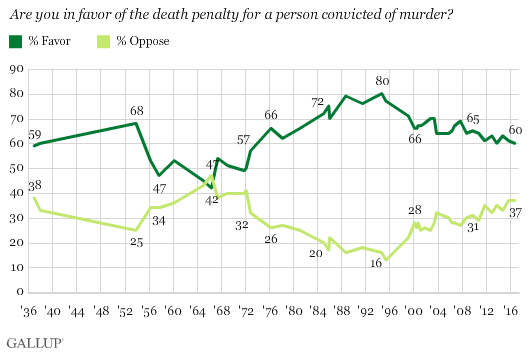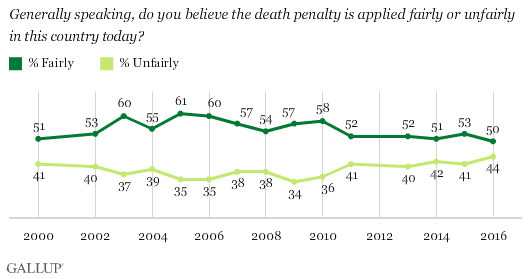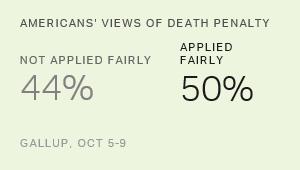Story Highlights
- Gallup has not found a lower level of support since 57% in 1972
- Support peaked at 80% in 1994
- Less than half of Democrats now favor the death penalty
PRINCETON, N.J. -- As voters in several states prepare to vote on death penalty initiatives, 60% of Americans say they are in favor of the death penalty for persons convicted of murder. This figure is similar to the 61% average since 2011 but down from 66% support between 2000 and 2010 and the all-time high of 80% in 1994. Support for the death penalty has not been lower since it was 57% in November 1972.

California, Nebraska and Oklahoma are the latest in a series of states to reconsider their death penalty laws. Voters will decide on the legality of the death penalty in those states in Election Day referenda.
The latest results on Gallup's basic death penalty question are based on Gallup's annual Crime poll, conducted Oct. 5-9. Gallup first asked this question in 1936 and has measured it 47 times in total, including at least annually since 1999.
Americans' current level of support for capital punishment is similar to what Gallup measured in 1936, when 59% favored the death penalty and 38% opposed it. These attitudes have fluctuated a great deal over the 80 years since.
Support for the death penalty increased to 68% in a 1953 survey conducted shortly after Julius and Ethel Rosenberg were convicted of spying for the Soviet Union and executed for their crimes. Americans' support for the death penalty then declined for the remainder of the 1950s and throughout much of the 1960s. During this time, legal experts debated whether the death penalty constituted "cruel and unusual punishment." Several successful legal challenges to various aspects of state death penalty laws led to a decade-long moratorium on U.S. executions from the mid-1960s to the mid-1970s.
In 1966, more Americans were opposed (47%) than in favor (42%) of the death penalty, the only time that has occurred in Gallup's trend. In 1972, the U.S. Supreme Court struck down all state death penalty statutes because of concerns of arbitrary sentencing.
Support for the death penalty recovered in the 1970s as states rewrote their statutes to address the Supreme Court's concerns and the new laws generally passed court muster. By 1976, less than a year before executions resumed in the U.S., two-thirds of Americans expressed support for the death penalty.
The percentage of Americans favoring the death penalty increased to 72% in January 1985 and stayed above 70% through 1999. This included the peak of 80% in 1994, a time when Americans overwhelmingly mentioned "crime" as the most important problem facing the U.S.
The year 2000 brought about renewed questions regarding the manner in which certain states applied the death penalty. Illinois adopted a moratorium after several death row inmates were exonerated of their crimes. In February 2000, 66% of Americans were in favor of the death penalty, with support holding at about that level through 2010. Eight states, including Illinois, have abolished the death penalty since 2007, and four others have moratoria in place.
The recent decline in U.S. support for the death penalty is mostly attributable to a decline in the percentage of Democrats favoring the practice. Democratic support has now dropped below the majority level, to an average 47% over the last five years from 55% in the prior decade. Independents have shown a smaller decrease over this time, with virtually no change among Republicans. Eight in 10 Republicans, and 61% of independents, favor the death penalty.
| 2000-2010 | 2011-2016 | Change | ||||||||||||||||||||||||||||||||||||||||||||||||||||||||||||||||||||||||||||||||||||||||||||||||||
|---|---|---|---|---|---|---|---|---|---|---|---|---|---|---|---|---|---|---|---|---|---|---|---|---|---|---|---|---|---|---|---|---|---|---|---|---|---|---|---|---|---|---|---|---|---|---|---|---|---|---|---|---|---|---|---|---|---|---|---|---|---|---|---|---|---|---|---|---|---|---|---|---|---|---|---|---|---|---|---|---|---|---|---|---|---|---|---|---|---|---|---|---|---|---|---|---|---|---|---|---|
| % | % | (pct. pts.) | ||||||||||||||||||||||||||||||||||||||||||||||||||||||||||||||||||||||||||||||||||||||||||||||||||
| Democrats | ||||||||||||||||||||||||||||||||||||||||||||||||||||||||||||||||||||||||||||||||||||||||||||||||||||
| Favor | 55 | 47 | -8 | |||||||||||||||||||||||||||||||||||||||||||||||||||||||||||||||||||||||||||||||||||||||||||||||||
| Oppose | 39 | 49 | +10 | |||||||||||||||||||||||||||||||||||||||||||||||||||||||||||||||||||||||||||||||||||||||||||||||||
| Independents | ||||||||||||||||||||||||||||||||||||||||||||||||||||||||||||||||||||||||||||||||||||||||||||||||||||
| Favor | 64 | 61 | -3 | |||||||||||||||||||||||||||||||||||||||||||||||||||||||||||||||||||||||||||||||||||||||||||||||||
| Oppose | 30 | 35 | +5 | |||||||||||||||||||||||||||||||||||||||||||||||||||||||||||||||||||||||||||||||||||||||||||||||||
| Republicans | ||||||||||||||||||||||||||||||||||||||||||||||||||||||||||||||||||||||||||||||||||||||||||||||||||||
| Favor | 80 | 79 | -1 | |||||||||||||||||||||||||||||||||||||||||||||||||||||||||||||||||||||||||||||||||||||||||||||||||
| Oppose | 16 | 17 | +1 | |||||||||||||||||||||||||||||||||||||||||||||||||||||||||||||||||||||||||||||||||||||||||||||||||
| Gallup | ||||||||||||||||||||||||||||||||||||||||||||||||||||||||||||||||||||||||||||||||||||||||||||||||||||
In stark contrast to now, in 1994 there were small party differences in death penalty support. Back then, 75% of Democrats, 80% of independents and 85% of Republicans said they favored capital punishment.
Half in U.S. Say Death Penalty Applied Fairly
Critics of the death penalty often argue it is applied unfairly in the U.S. For example, crime statistics show blacks are much more likely than whites to receive death sentences. Americans as a whole are more inclined to say the death penalty is applied fairly (50%) than to say it is not (44%). However, the percentage saying the death penalty is applied fairly is the lowest in Gallup's 17-year trend, although there have been several other readings near 50%.

Since 2011, an average 52% of Americans have said the death penalty is applied fairly. From 2000 to 2010, the average was 57%. That matches the five-percentage-point decline in the percentage of Americans who favor the death penalty.
When asked about the frequency with which the death penalty is used, the largest proportion of Americans say it is not used often enough rather than used too often or used about the right amount. But the percentage of Americans who believe the death penalty is not imposed often enough has decreased in recent years. From 2001 to 2010, an average 48% of Americans said the death penalty was not used enough; over the past five years, the average is 41%. At the same time, 25% in this decade -- compared with 21% in the prior decade -- say the death penalty is imposed too often.

Implications
Americans historically have been more likely to favor than oppose the death penalty, and a solid majority of 60% still endorse it. But support has slipped in recent years and is the lowest Gallup has measured since 1972, when the Supreme Court invalidated capital punishment laws.
This is reflected in, or perhaps the force behind, changes in death penalty laws in recent years, with a total of 12 states abolishing the death penalty or imposing a moratorium in the last decade alone. Although there are exceptions, most Democratic-leaning states have abolished the death penalty, whereas most Republican-leaning states, particularly those in the South and West, continue to allow it.
In several states, including Nebraska, California and Oklahoma, voters this fall will attempt to decide the future of the death penalty in their state. Nebraska legislators abolished the death penalty in 2015, and this year voters will decide whether that action will stand or be turned back. California voters will determine whether the death penalty remains legal in their state. And Oklahoma voters are deciding on a measure that would formally add language to the state's constitution to recognize the death penalty as a legal form of punishment.
Historical data are available in Gallup Analytics.
Survey Methods
Results for this Gallup poll are based on telephone interviews conducted Oct. 5-9, 2016, with a random sample of 1,017 adults, aged 18 and older, living in all 50 U.S. states and the District of Columbia. For results based on the total sample of national adults, the margin of sampling error is ±4 percentage points at the 95% confidence level. All reported margins of sampling error include computed design effects for weighting.
Each sample of national adults includes a minimum quota of 60% cellphone respondents and 40% landline respondents, with additional minimum quotas by time zone within region. Landline and cellular telephone numbers are selected using random-digit-dial methods.
View complete question responses and trends.
Learn more about how the Gallup Poll Social Series works.


